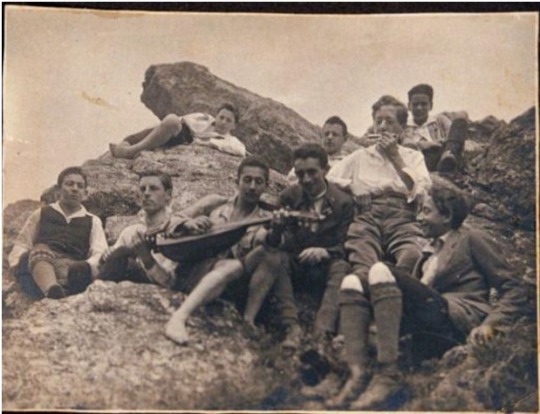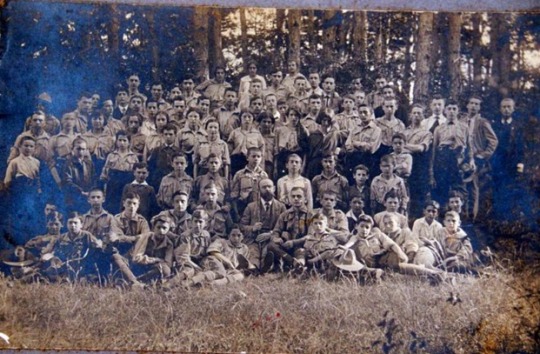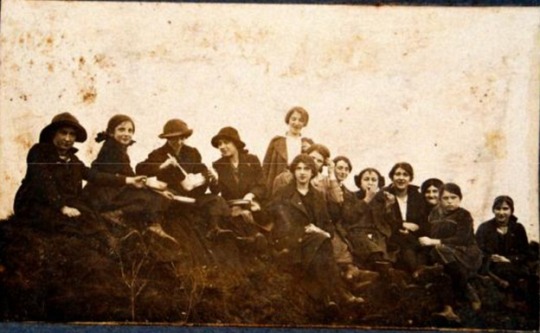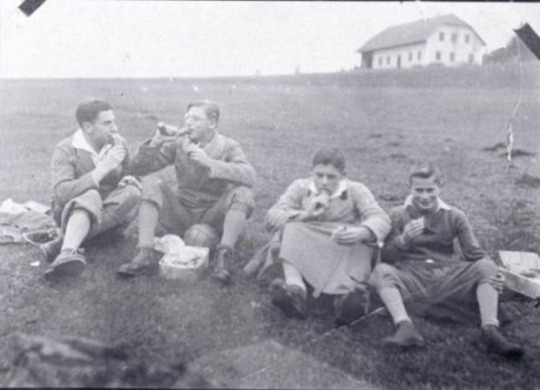
Image: Courtesy of Leo Baeck Institute
By James Benjamin Nadel, Communications Outreach Associate
As the summer ends, and opportunities to explore the great outdoors grow fewer, I wanted to draw attention to the little discussed history of Jewish hiking organizations. Several of these youth groups existed in pre-World War II Europe, but one stands out in particular for its unique engagement with various cultural identities. Blau-Weiss (Blue-White) was a Zionist youth organization that was active in Germany from 1912-1926. The group, which had branches in various German cities, organized hiking and camping trips aimed at bringing Jewish children and teenagers into contact with nature. At its height in 1923, the movement consisted of 3,000 members. To mark the end of the season, a series of several archival items (from the Leo Baeck Institute) related to Blau-Weiss are currently on display in the Great Treasures in the Great Hall case.
At its inception, Blau-Weiss was modeled after German youth groups (wandervogel), which formed at the beginning of the century and which celebrated the German landscape. Rejecting the mechanization and materialism of urban life, these groups believed that they could connect with their German culture and roots by communing with nature. Blau-Weiss emulated the ideology of these groups, many of which barred Jewish members, and took up their commitment to hiking, singing and telling stories around a bonfire. The famous Jewish philosopher Gershom Sholem even criticized Blau-Weiss for mimicking German culture organizations too closely. Despite these denigrations, Blau-Weissers too took pride in their German heritage, singing German songs and reciting Romantic poetry on their trips into the wilderness. Indeed, the Blau-Weiss “Liederbuch” (on display), which Blau-Weiss group leaders would consult on their hikes, contains classic German folk songs like “Ein Jäger aus Karpfalz.”

Image: Courtesy of Leo Baeck Institute
However, this same liederbuch also contained many songs in Yiddish and Hebrew. Many artifacts that the Blau-Weiss left behind demonstrate the group’s simultaneous commitment to both Jewish and German culture. One such piece (also on display) is a 1916 diary (Tagebuch) that was made, as its cover declares, for a “Judische Wandrer” (Jewish Wanderer) in a Blau-Weiss group. Inside, the Tagebuch has several features, including a calendar with Jewish and German holidays, several pages for writing down thoughts, and illustrations of natural and Jewish imagery. One image pictures flowers in bloom, while the next is of a lit menorah.
The group also blended its activities with Jewish traditions and culture. Group leaders insisted on the importance of learning Hebrew. They greeted each other by saying “Shalom,” and kept kosher on their trips. They read Theodor Herzl and Martin Buber, and the flames of the campfire were often compared to the candles on the menorah. In this way, the group was similar to other Jewish scouting movements in Eastern Europe, like the Max Weinreich’s “Di Bin,” (The Bee) which was dedicated to Yiddish culture, and the Bundist “Tsukunft,” (The Future). The YIVO Institute for Jewish Research holds rich archival collections for each of these groups.

Image: Courtesy of Leo Baeck Institute
However, as opposed to these groups, Blau-Weiss focused its ideology around Zionism and the pursuit of a Jewish state. By the middle of the 1920s, the vast majority of the group’s activities were pointed towards settlement in Palestine. In 1921, the group set up a “model” settlement in Karlsruhe, Germany in order to practice the skills that they thought would need for Aliyah. Hiking trips became opportunities to further train for this new life. Starting in 1923, Blau-Weiss established settlements in Palestine, only to find that they were not yet prepared to live in their new environment. By 1926, with their efforts dashed, the organization dissolved.
Despite this eventual decline, Blau-Weiss and its members exemplify the complexities of German-Jewish identity. For these young Jews, hiking and exploration became a metaphor for expressing their dedication to both their Jewish identity and their German homeland, as well as understanding their place in society.

Image: Courtesy of Leo Baeck Institute
Want to see Blau-Weiss groups in action? Click here to browse
photographs from the
Rudolf and Rudolphina Menzel
collection, including more photos of group, in the the Leo Baeck Institute archives.
Further Reading
Sharfman, Glenn R. “Between Identities: The German-Jewish Youth Movement Blau-Weiss, 1912-26.” Forging,(eds.) M. Berkowitz, SL Tananbaum, and SW Bloom (2003): 198-228.
Reinharz, Jehuda. “Ideology and Structure in German Zionism, 1882-1933.” Jewish Social Studies 42.2 (1980): 119-146.
